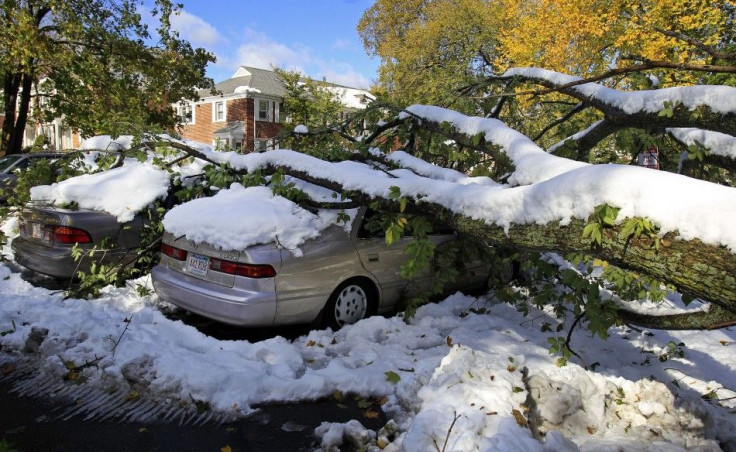October Storm Downs Trees, Power Lines and Snowfall Records in Northeast

Nobody dreams of a white Halloween, but millions of people throughout the Northeast got that and more on Saturday when a northeaster dumped several inches of snow and toppled trees and power lines throughout the region.
At least 12 people died from falling tree limbs, electrocutions or traffic accidents, and more than two million were still without power as of Monday morning, with regional electric utilities warning that some customers might be in the dark for a week or more. Fallen tree limbs snarled the morning commute, and downed power lines made venturing outside treacherous on a day when millions of children would otherwise have gone trick-or-treating.
The amount of snow was astonishing for October, with 19 inches in West Milford, N.J., 22 inches in Concord, N.H., and 32 inches in Peru, Mass., according to AccuWeather.com.
New York City saw much less accumulation -- 2.9 inches in Central Park, and between one and two inches in the outer boroughs -- but it was enough to shatter the city's previous record for October snowfall, which was 0.8 inches on Oct. 30, 1925.
In fact, the storm shattered October single-day snowfall records almost everywhere. Hartford, Conn., whose previous record was 1.7 inches on Oct. 10, 1979, received 12.3 inches of snow on Saturday. Concord, N.H., received 13.6 inches on Saturday and several more on Sunday, blowing the previous record of 0.2 inches in 1952 out of the water.
Washington, D.C., got just 0.6 inches, but it was the first time the capital had ever seen snow before Oct. 30.
Even in places where snowfall totals were low, a number of factors combined to make the storm unusually devastating in terms of damage to trees and power lines. Because the temperature was near freezing -- if it had been just a few degrees warmer in New York, it would have been rain -- the snow was wet and heavy. Also, the leaves had not yet fallen, so the snow clung to the leaves rather than falling through bare branches.
The combination of those two factors felled nearly 1,000 trees in Central Park. Douglas Blonsky, the president of the Central Park Conservancy, told The New York Times it was the worst damage he had seen in his 27 years with the group.
Outside of the city, suburban residents said they heard noises like gunshots as fully grown, healthy trees just snapped.
Wild Weather Period Continues
The northeaster was the latest in a string of unusual weather events to hit the United States in the past year.
Last December, a blizzard dumped between 12 and 34 inches of snow along the Eastern Seaboard, from North Carolina to Canada. A series of tornado outbreaks hit the South and the Midwest in April and May, with one tornado -- the worst the country has seen since 1947 -- devastating Joplin, Mo. Texas has spent months suffering through the worst drought in its history, while flooding from the Mississippi River has ravaged other areas. And, of course, there was Hurricane Irene in August.
M. Sanjayan, a lead scientist with the Nature Conservancy, the world's largest conservation organization, told CBS News that the increased frequency of extreme weather events was attributable to two factors: climate change and La Niña, a periodic phenomenon in which the Pacific Ocean is cooler than normal.
La Niña years tend to bring snow, particularly to the north part of the country, Sanjayan said. As for climate change, it's going to continue, so we are going to be in for more wacky weather, if you'd like.
But, while the pattern of more frequent extreme weather events is cause for concern, it is too early to say whether this particular storm is a harbinger of a difficult winter.
There's always going to be anomalous events, Aaron Tyburski, a meteorologist in State College, Pa., told The Associated Press. While it is quite an event, we may go the next month and not get any snow.
© Copyright IBTimes 2024. All rights reserved.











